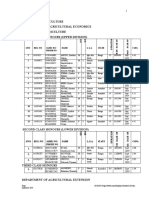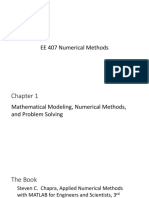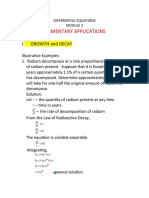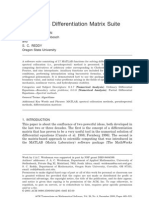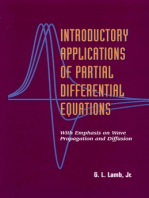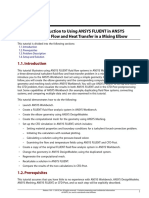Matlab Solution
Uploaded by
Angel NgoMatlab Solution
Uploaded by
Angel NgoEAB 2113 NUMERICAL METHOD
Question 1
Develop an M-file to implement the bisection method. Using this program solve the
following problem.
The velocity of falling parachutist is given as
v(t ) =
gm
(1 e ( c / m ) t ) .
c
Where v (t ) = velocity of parachutist = 40 m / s ,
g = gravitational constant = 9.8 m / s 2 ,
m = the mass of the parachutist = 68.1 kg .
Find the drag coefficient, c at the time t = 10 seconds using the initial bracket
of the root as [13, 16] and iterate until a 0.001 %.
% Data obtain from the question
f=inline('((9.81*68.1)/x)*(1-exp(-(x/68.1)*10))-40','x');
xl=13;
xu=16;
es=0.001;
%computation
xr=xl; %initiation
while(1) %since we dont know how many interation will take place
xrold=xr; %keep the previous xr
xr=(xl+xu)/2; %formula for bisection method
if xr~=0, ea=abs((xr-xrold)/xr)*100; end %calculate ea if xr not real
answer
test=f(xl)*f(xr);
if test<0
xu=xr;
elseif test>0
xl=xr;
else ea=0;
end
end
if ea<=es, break,end %end loop if the situation is satisfied
format long;
disp('the root for this equation is : ')
disp(xr)
EAB 2113 NUMERICAL METHOD
Question 2
2
EAB 2113 NUMERICAL METHOD
Develop an M-file to implement the false position method. solve the following
problem.
The velocity of falling parachutist is given as
v(t ) =
gm
(1 e ( c / m ) t ) .
c
Where v (t ) = velocity of parachutist = 40 m / s ,
g = gravitational constant = 9.8 m / s 2 ,
m = the mass of the parachutist = 68.1 kg .
Find the drag coefficient, c at the time t = 10 seconds using the initial bracket
of the root as [13, 16] and iterate until a 0.001 %.
f=inline('((9.81*68.1)/x)*(1-exp (-(x/68.1)*10))-40','x');
xl=13;
xu=16;
es=0.001;
xr=xl
while (1)
xrold=xr;
xr=xu-(((f(xu)*(xl-xu))/f(xl)-f(xu)));
if xr~=0, ea=abs((xr-xrold)/xr)*100; end
test=f(xl)*f(xr);
if test<0
xu=xr;
elseif test>0
xl=xr;
else test>0
ea=0;
end
if ea<=es, break, end
end
format long;
disp ('the root for this equation is : ')
disp(xr)
EAB 2113 NUMERICAL METHOD
Question 3
4
EAB 2113 NUMERICAL METHOD
Locate the root of f ( x ) = 2 sin( x ) x
x0 = 2 .
(a)
Using the MATLAB function fzero with an initial guess of
(b)
Using Newton-Raphson method by writing a function M-file. Use an
initial guess of x 0 = 0.5 and iterate until a 0.001 %.
a)
function root=newraph1(f,df,xr,es)
%f=inline('2*sin(sqrt(x))-x')
%df=inline('-cos(sqrt(x))/sqrt(x)-1')
while(1)
xr_old=xr;
xr=xr-(f(xr)/df(xr));
if xr~=0,ea=abs((xr-xr_old)/xr)*100;
end
if ea<=es,break,end
end
fprintf('\n\nthe root for this question is %2.6f\n',xr);
EAB 2113 NUMERICAL METHOD
Question 4
EAB 2113 NUMERICAL METHOD
Develop an M-file to implement the modified secant method. Using this
program determine the loest positive root of f ( x) = 8 sin( x) e x 1 with an
initial guess of x 0 = 0.3 and = 0.01 . Iterate until a = 0.000001% .
f=inline('8*sin(x)*exp(-x)-1','x')
Ea=1;
xo=0.3;
fprintf('The initial guess is %.2f',xo)
while(Ea>0.000001)
xold=xo;
xo=xo-(0.01*xo*f(xo))/(f(xo+0.01+xo)-f(xo));
Ea=((abs(xo-xold))/xo)*100;
end
fprintf('\nThe lowest positive root of function is %10.6f with approximate
error %7.4f',xo,Ea)
Question 5
EAB 2113 NUMERICAL METHOD
Find the solution of the following set of linear algebraic equations
x + 2 y + 3z =1
3 x + 3 y + 4 z =1
2 x + 3 y + 3z = 2
a) Using the left division
b) Using Gaussian elimination
c) Using LU decomposition
8
EAB 2113 NUMERICAL METHOD
Question 6
EAB 2113 NUMERICAL METHOD
Develop a function M-file Tridiag.m to solve the following tridiagonal system
with the Thomas algorithm.
f1
e
2
g1
f2
g2
e3
f3
g3
.
.
.
.
e n 1
f n 1
en
x1 r1
x r
2 2
x3 r3
. = .
. .
. .
g n 1 x n 1 rn 1
f n x n rn
Thomas Algorithm:
(i)
Decomposition:
e
e k = k and
f k 1
f k = f k ek . g k 1 , where k = 2,3,4, , n .
(ii)
Forward substitution:
rk = rk e k . rk 1 , where k = 2,3,4, , n .
(iii)
Back substitution:
r
xn = n
fn
and x k =
( rk g k . x k +1 )
, where k = n 1, n 2, ,2,1 .
fk
Using
your program, solve the following tridiagonal system.
function
x=Tri(e,f,g,r)
%e=input('e= ');
%f=input('f=
01475
0.020875
2.');
x1 4.175
0.');
x 0
%g=input('g=
020875
2.01475
0.020875
%r=input('r=
');
x3 = 0
0
.
020875
2
.
01475
0
.
020875
e=[0 -0.020875 -0.020875 -0.020875];
f=[2.01475
0.020875
2.01475 x 2.0875
2.01475 2.01475 2.01475];
4
g=[-0.020875 -0.020875 -0.020875 0];
r=[4.175 0 0 2.0875];
n=length(f);
for k=2:n
factor=e(k)/f(k-1);
f(k)=f(k)-factor*g(k-1);
r(k)=r(k)-factor*r(k-1);
fprintf('factor=%2.4f\t f(k)=%2.4f\t
end
x(n)=r(n)/f(n);
for k=n-1:-1:1
x(k)=(r(k)-g(k)*x(k+1))/f(k);
fprintf('x(k)=%2.4f\n',x(k))
end
r(k)=%2.4f\n',factor,f(k),r(k))
10
EAB 2113 NUMERICAL METHOD
Question 7
11
EAB 2113 NUMERICAL METHOD
Q7.
Develop a MATLAB script file to determine the solution of the following system of
linear equations using the Gauss-Seidel iteration method by performing first seven
iterations.
9 x1 2 x 2 + 3 x3 + 2 x 4 = 54.5
2 x1 + 8 x 2 2 x3 + 3x 4 = 14
3 x1 + 2 x 2 + 11x3 4 x 4 = 12.5
2 x1 + 3 x 2 + 2 x3 + 10 x 4 = 21
i=1;x1=0;x2=0;x3=0;x4=0;
disp(' i
x1
x2
x3
x4')
fprintf('%2.0f %8.5f %8.5f %8.5f %8.5f\n',i,x1,x2,x3,x4)
for i=2:8
x1=(54.5-(-2*x2+3*x3+2*x4))/9;
x2=(-14-(2*x1-2*x3+3*x4))/8;
x3=(12.5-(-3*x1+2*x2-4*x4))/11;
x4=(-21-(-2*x1+3*x2+2*x3))/10;
fprintf('%2.0f %8.5f %8.5f %8.5f %8.5f\n',i,x1,x2,x3,x4)
end
Question 8
12
EAB 2113 NUMERICAL METHOD
Develop a script M-file to estimate f ( 2.75) using Lagrange interpolating polynomials
of order 1, 2 and 3 for the following data.
x
f(x
)
0
0
1
0.5
2
0.8
3
0.9
4
0.941176
5
0.961538
For each estimate find the true percent relative error if the try function is
given by f ( x ) =
x2
.
(1 + x 2 )
function fint=LagrangeINT(x,y,xint)
n=length(x);
for i=1:n
L(i)=1;
for j=1:n
if j~=i
L(i)=L(i)*(xint-x(j))/(x(i)-x(j));
end
end
end
f=(xint^2)/(1+xint^2);
et=abs((f-sum(y.*L))/f)/100;
fprintf('\nx=%.8f\n',sum(y.*L));
fprintf('Error=%6f%%\n',et);
13
EAB 2113 NUMERICAL METHOD
Question 9
.
The force on a sailboat mast can be represented by the following function:
H
z 2.5 z / H
F = 200
dz
e
0
7 + z
where z = the elevation above the deck and H = the height of the mast.
Compute F for the case where H = 30 using
(i)
the M-file for Trapezoidal rule with the step size h = 0.1 .
the MATLAB trapz function.
function evaluate = trapezoidal1(f,H,h)
%f=inline('200*(z/(7+z))*exp(-25*z/30)')
%y(for the trapz function)=200*(z./(7+z)).*exp(-25.*z./30)
a=0;
while(1)
n=(H-a)/h;
t0=f(a);
t1=0;
for i=1:n-1
t1=t1+f(a+h*i);
end
t2=f(H);
value=h/2*(t0+2*t1+t2);
break
end
fprintf('The Trapezoidal Integral: %2.8f\n',value)
Question 10
14
EAB 2113 NUMERICAL METHOD
Develop an M-file to implement Simpsons 1/3 rule. Using your program solve
the following problem.
The velocity of falling parachutist is given as
v (t ) =
gm
(1 e ( c / m ) t ) .
c
Where v (t ) = velocity of parachutist,
g = gravitational constant = 9.8 m / s 2 ,
m = mass of the parachutist =
45 kg ,
= the drag coefficient = 32.5 kg / s .
If the distance, d, traveled by the parachutist is given by
6
d = v(t ) dt ,
0
find the distance using Simpsons 1/3 rule for the segments 10, 20, 50, and
100.
function distance=simpson(V,a,b,n)
h=(b-a)/n;
t(1)=a;
for i=2:n+1
t(i)=t(i-1)+h;
end
P=0;
for i=2:2:n
P=P+V(t(i));
end
T=0;
for i=3:2:n-1
T=T+V(t(i));
end
d=(h/3)*(V(a)+(4*P)+(2*T)+V(b));
fprintf('\nThe distance travelled by the parachutist=%9.6f\n',d)
15
EAB 2113 NUMERICAL METHOD
16
EAB 2113 NUMERICAL METHOD
Question 11
Develop an M-file for Eulers method to solve a first order ordinary differential
equation (ODE).
i(t)
E
The current around the circuit at time
differential equation
3
di
= 2i + 3e 2t ,
dt
t is governed by the following
i ( 0) = 2 .
Using your program, solve the above initial value problem over the interval
from t = 0 to 2 with the step size h = 0.1 .
function [t,i]= Eulode(didt,tspan,i0,h)
%input:
%didt= name of the function f(t,i)
%tspan= [ti,tf] where ti and tf= initial and final valus of independent
%variable
%y0= initial value of the dependent variable
%h=step size
%output:
%[t,i] where t= vector of the independent variable
%
i= vector of the solution for the dependent variable
tx=tspan(1);
ty=tspan(2);
t=(tx:h:ty)';
n=length(t);
i=i0*ones(n,1);
for x=1:n-1
i(x+1)=i(x)+feval(didt,t(x),i(x))*h;
end
17
EAB 2113 NUMERICAL METHOD
18
EAB 2113 NUMERICAL METHOD
Question 12
Develop an M-file for Fourth-Order Runge-Kutta method to solve a first order
ordinary differential equation (ODE).
Using your program solve the following initial value problem over the interval
from x = 0 to 2 with the step size h = 0.2 .
dy
= x2 + y ,
dx
y ( 0 ) = 0 .8 .
function [x,y]=rk40de(dydx,xspan,y0,h)
xi=xspan(1);
xf=xspan(2);
x=(xi:h:xf)';
n=length(x);
y=y0*ones(n,1);
for i=1:n-1
k1=feval(dydx,x(i),y(i));
k2=feval(dydx,x(i)+(1/2)*h,y(i)+(1/2)*k1*h);
k3=feval(dydx,x(i)+(1/2)*h,y(i)+(1/2)*k2*h);
k4=feval(dydx,x(i)+h,y(i)+k3*h);
y(i+1)=y(i)+(1/6)*(k1+2*k2+2*k3+k4)*h;
end
19
EAB 2113 NUMERICAL METHOD
20
You might also like
- Advanced Mathematics For ME Final ExaminationNo ratings yetAdvanced Mathematics For ME Final Examination7 pages
- Practice Exercise 1: Suppose You Wish To Build A Model That Will Help Determine If0% (1)Practice Exercise 1: Suppose You Wish To Build A Model That Will Help Determine If4 pages
- CS2 B Chapters 4 and 5 - Markov Jump Processes - QuestionsNo ratings yetCS2 B Chapters 4 and 5 - Markov Jump Processes - Questions3 pages
- Elementary Applications: I. Growth and DecayNo ratings yetElementary Applications: I. Growth and Decay5 pages
- Newton's Divided Difference Interpolation FormulaNo ratings yetNewton's Divided Difference Interpolation Formula31 pages
- Lesson 31 Linear Differential Equation of Higher Order: Module 3: Ordinary Differential EquationsNo ratings yetLesson 31 Linear Differential Equation of Higher Order: Module 3: Ordinary Differential Equations6 pages
- 01 Numerical Solution of Nonlinear EquationsNo ratings yet01 Numerical Solution of Nonlinear Equations84 pages
- Applications of Differential Equations: Orthogonal TrajectoriesNo ratings yetApplications of Differential Equations: Orthogonal Trajectories8 pages
- Topic 3-Part 1-Poles-and-Zeros-of-Transfer-Function.-Pole-Zero-MapNo ratings yetTopic 3-Part 1-Poles-and-Zeros-of-Transfer-Function.-Pole-Zero-Map23 pages
- Simple Fixed Point Iteration Method PDFNo ratings yetSimple Fixed Point Iteration Method PDF11 pages
- Lesson 1 Differential Calculus IntroductionNo ratings yetLesson 1 Differential Calculus Introduction73 pages
- Laboratory Activity 2 - Newton Raphson and Secant Method100% (1)Laboratory Activity 2 - Newton Raphson and Secant Method8 pages
- Phase Plane For Linear Control System and Design0% (1)Phase Plane For Linear Control System and Design206 pages
- Applications of First Order Differential Equation: DR Mansoor AlshehriNo ratings yetApplications of First Order Differential Equation: DR Mansoor Alshehri39 pages
- Chap 06 of Numerical Methods For Engineers by Chapra and CanaleNo ratings yetChap 06 of Numerical Methods For Engineers by Chapra and Canale53 pages
- Numerical Solution of Ordinary Differential Equations Part 2 - Nonlinear EquationsNo ratings yetNumerical Solution of Ordinary Differential Equations Part 2 - Nonlinear Equations38 pages
- Solving ODEs With The Laplace Transform in MatlabNo ratings yetSolving ODEs With The Laplace Transform in Matlab4 pages
- Process Dynamics and Control 4th Class HW PDFNo ratings yetProcess Dynamics and Control 4th Class HW PDF13 pages
- Solved Examples For Method of Undetermined CoefficientsNo ratings yetSolved Examples For Method of Undetermined Coefficients3 pages
- Chapter 2 Modeling in The Frequency Domain Skill-Assessment Exercise 2.5No ratings yetChapter 2 Modeling in The Frequency Domain Skill-Assessment Exercise 2.54 pages
- Sanchez 07 Poles and Zeros of Transfer FunctionsNo ratings yetSanchez 07 Poles and Zeros of Transfer Functions20 pages
- ES 209 Engineering Data Analysis - Long QuizNo ratings yetES 209 Engineering Data Analysis - Long Quiz3 pages
- Introductory Methods of Numerical Analysis: Fifth EditionNo ratings yetIntroductory Methods of Numerical Analysis: Fifth Edition11 pages
- Introductory Applications of Partial Differential Equations: With Emphasis on Wave Propagation and DiffusionFrom EverandIntroductory Applications of Partial Differential Equations: With Emphasis on Wave Propagation and DiffusionNo ratings yet
- Differential Equations (Calculus) Mathematics E-Book For Public ExamsFrom EverandDifferential Equations (Calculus) Mathematics E-Book For Public Exams5/5 (1)
- Matlab Assignment and Test Questions - May 2016 SemNo ratings yetMatlab Assignment and Test Questions - May 2016 Sem4 pages
- Introduction To Using ANSYS FLUENT in ANSYS Workbench Fluid FlowNo ratings yetIntroduction To Using ANSYS FLUENT in ANSYS Workbench Fluid Flow75 pages
- 2.1 PCB 3013 Exercise 1 Diffusivity 30MAY13No ratings yet2.1 PCB 3013 Exercise 1 Diffusivity 30MAY138 pages
- Hollow Block (20x20x40) (Sampling Date 24-06-2023)No ratings yetHollow Block (20x20x40) (Sampling Date 24-06-2023)2 pages
- CTET - Syllabus: Structure and Content of SyllabusNo ratings yetCTET - Syllabus: Structure and Content of Syllabus18 pages
- Teelit Date: Oct. 4-8, 2021 Detailed Lesson Plan About LegendsNo ratings yetTeelit Date: Oct. 4-8, 2021 Detailed Lesson Plan About Legends2 pages
- Handout+Home Assignment For CSE 2022 BATCHNo ratings yetHandout+Home Assignment For CSE 2022 BATCH7 pages
- Topic 1 - Introduction of Production and Operation ManagementNo ratings yetTopic 1 - Introduction of Production and Operation Management16 pages
- Schedule For Summer Special Reappear (First Year Engineering)No ratings yetSchedule For Summer Special Reappear (First Year Engineering)6 pages
- Business Negotiations - Unit 1 - Business Negotiations Week-1 QUIZ ANSWERSNo ratings yetBusiness Negotiations - Unit 1 - Business Negotiations Week-1 QUIZ ANSWERS3 pages
- Couple Therapy Disorganized Attachment DynamicsNo ratings yetCouple Therapy Disorganized Attachment Dynamics11 pages
- [Ebooks PDF] download Behavior Trees in Robotics and Al: An Introduction 1st Edition Michele Collendanchise full chapters100% (2)[Ebooks PDF] download Behavior Trees in Robotics and Al: An Introduction 1st Edition Michele Collendanchise full chapters65 pages
- Regenerative Bhutan Report Summary - Vclean100% (1)Regenerative Bhutan Report Summary - Vclean15 pages
- Ebook 35 Resume Mistakes by Alex BERGHOFEN 2023-02-12No ratings yetEbook 35 Resume Mistakes by Alex BERGHOFEN 2023-02-1233 pages
- Practice Exercise 1: Suppose You Wish To Build A Model That Will Help Determine IfPractice Exercise 1: Suppose You Wish To Build A Model That Will Help Determine If
- CS2 B Chapters 4 and 5 - Markov Jump Processes - QuestionsCS2 B Chapters 4 and 5 - Markov Jump Processes - Questions
- Lesson 31 Linear Differential Equation of Higher Order: Module 3: Ordinary Differential EquationsLesson 31 Linear Differential Equation of Higher Order: Module 3: Ordinary Differential Equations
- Applications of Differential Equations: Orthogonal TrajectoriesApplications of Differential Equations: Orthogonal Trajectories
- Topic 3-Part 1-Poles-and-Zeros-of-Transfer-Function.-Pole-Zero-MapTopic 3-Part 1-Poles-and-Zeros-of-Transfer-Function.-Pole-Zero-Map
- Laboratory Activity 2 - Newton Raphson and Secant MethodLaboratory Activity 2 - Newton Raphson and Secant Method
- Applications of First Order Differential Equation: DR Mansoor AlshehriApplications of First Order Differential Equation: DR Mansoor Alshehri
- Chap 06 of Numerical Methods For Engineers by Chapra and CanaleChap 06 of Numerical Methods For Engineers by Chapra and Canale
- Numerical Solution of Ordinary Differential Equations Part 2 - Nonlinear EquationsNumerical Solution of Ordinary Differential Equations Part 2 - Nonlinear Equations
- Solved Examples For Method of Undetermined CoefficientsSolved Examples For Method of Undetermined Coefficients
- Chapter 2 Modeling in The Frequency Domain Skill-Assessment Exercise 2.5Chapter 2 Modeling in The Frequency Domain Skill-Assessment Exercise 2.5
- Introductory Methods of Numerical Analysis: Fifth EditionIntroductory Methods of Numerical Analysis: Fifth Edition
- Introductory Applications of Partial Differential Equations: With Emphasis on Wave Propagation and DiffusionFrom EverandIntroductory Applications of Partial Differential Equations: With Emphasis on Wave Propagation and Diffusion
- Differential Equations (Calculus) Mathematics E-Book For Public ExamsFrom EverandDifferential Equations (Calculus) Mathematics E-Book For Public Exams
- Matlab Assignment and Test Questions - May 2016 SemMatlab Assignment and Test Questions - May 2016 Sem
- Introduction To Using ANSYS FLUENT in ANSYS Workbench Fluid FlowIntroduction To Using ANSYS FLUENT in ANSYS Workbench Fluid Flow
- Hollow Block (20x20x40) (Sampling Date 24-06-2023)Hollow Block (20x20x40) (Sampling Date 24-06-2023)
- CTET - Syllabus: Structure and Content of SyllabusCTET - Syllabus: Structure and Content of Syllabus
- Teelit Date: Oct. 4-8, 2021 Detailed Lesson Plan About LegendsTeelit Date: Oct. 4-8, 2021 Detailed Lesson Plan About Legends
- Topic 1 - Introduction of Production and Operation ManagementTopic 1 - Introduction of Production and Operation Management
- Schedule For Summer Special Reappear (First Year Engineering)Schedule For Summer Special Reappear (First Year Engineering)
- Business Negotiations - Unit 1 - Business Negotiations Week-1 QUIZ ANSWERSBusiness Negotiations - Unit 1 - Business Negotiations Week-1 QUIZ ANSWERS
- [Ebooks PDF] download Behavior Trees in Robotics and Al: An Introduction 1st Edition Michele Collendanchise full chapters[Ebooks PDF] download Behavior Trees in Robotics and Al: An Introduction 1st Edition Michele Collendanchise full chapters
- Ebook 35 Resume Mistakes by Alex BERGHOFEN 2023-02-12Ebook 35 Resume Mistakes by Alex BERGHOFEN 2023-02-12

